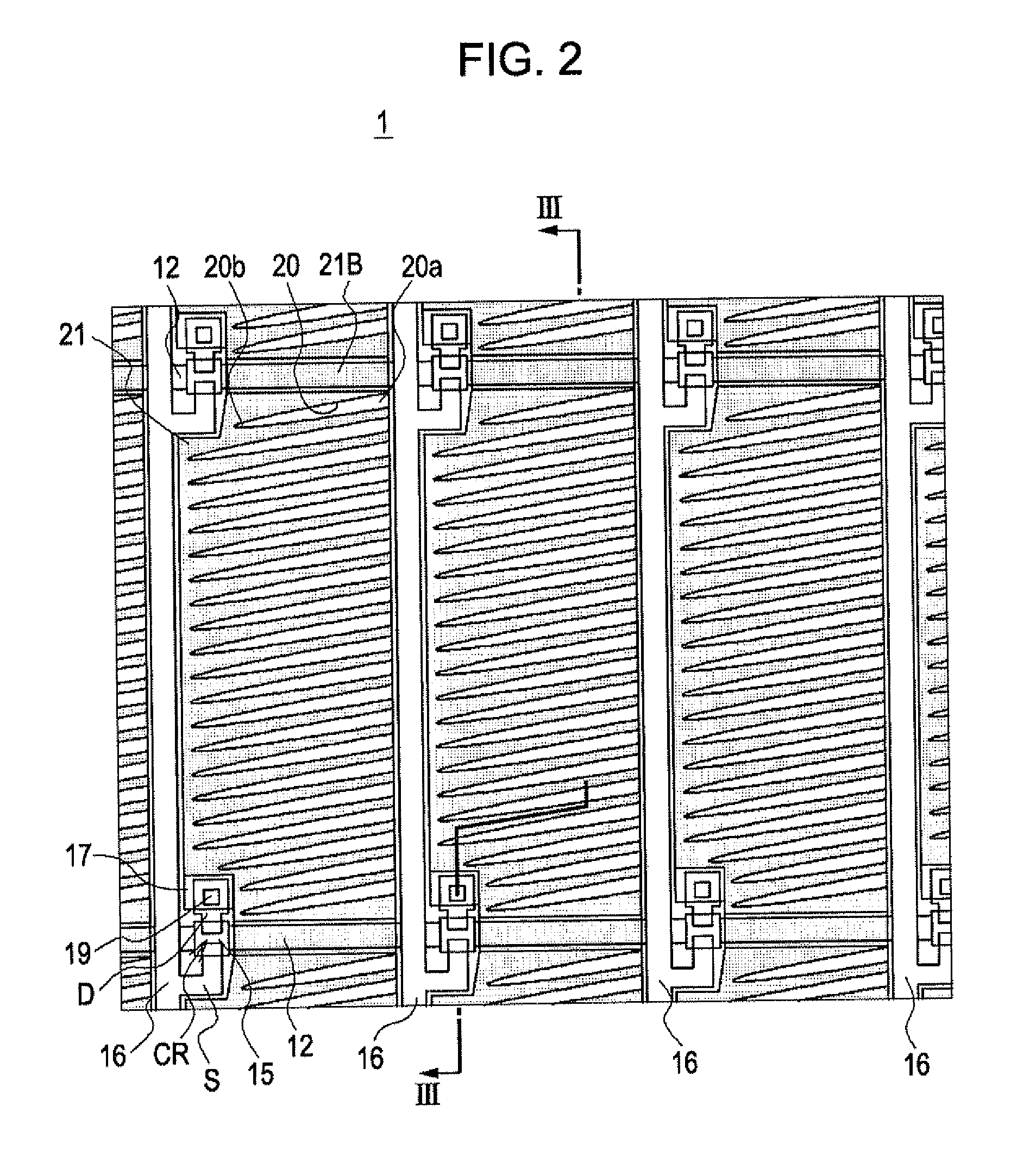Liquid crystal display device and manufacturing method thereof
a liquid crystal display device and switching mode technology, applied in semiconductor devices, instruments, optics, etc., can solve the problems of lowering the transmissivity and other aspects, insufficient driving, and reducing the aperture ratio, so as to achieve high throughput of liquid crystal display devices, reduce the variation in the characteristics of tfts, and high reliability
- Summary
- Abstract
- Description
- Claims
- Application Information
AI Technical Summary
Benefits of technology
Problems solved by technology
Method used
Image
Examples
first embodiment
[0063]As shown in FIG. 1, a liquid crystal display device 1 according to the embodiment is a so-called chip on glass (COG) type liquid crystal display device which includes an array substrate AR, a color filter substrate CF, a sealing member 2 bonding the array substrate AR and the color filter substrate CF together, and liquid crystals 30 (see FIG. 3) enclosed in a region surrounded by the array substrate AR, the color filter substrate CF, and the sealing member 2. In this liquid crystal display device 1, a region surrounded by the sealing member 2 forms a display area DA and the peripheral portion of the display area DA serves as a frame area. The sealing member 2 has formed therein an inlet 2a for injection of the liquid crystals 30. Referring to FIG. 1, the region corresponding to the display area DA is indicated as a shaded area with a grid pattern.
[0064]The array substrate AR is configured with a transparent substrate 11 which is formed of glass or the like and has various lin...
second embodiment
[0088]A liquid crystal display device 1A of the second embodiment has a structure such that the first electrode 17 of the display area DA extends so as to cover the TFTs used as the switching elements as viewed in plan view, as illustrated in FIGS. 8A and 9, and other structures are the same as those of the liquid crystal display device of the first embodiment.
[0089]Since the first electrode 17 is formed so as to cover the TFTs as viewed in plan view, the TFTs are covered with the first electrode 17 as well as the interlayer resin film 14 and the second insulating film 18. Therefore, according to the liquid crystal display device 1A of the second embodiment, the first electrode 17 can sufficiently function as the protective film, and it is thus possible to more effectively suppress variation in the characteristics of the switching elements due to external causes and to ensure long-term reliability of the switching elements.
third embodiment
[0090]A liquid crystal display device 1B of the third embodiment has a structure such that the second electrode 21 of the display area DA extends so as to cover the TFTs used as the switching elements as viewed in plan view, as illustrated in FIGS. 8B and 10, and other structures are the same as those of the liquid crystal display device of the first embodiment.
[0091]Since the second electrode 21 is formed so as to cover the TFTs as viewed in plan view, the TFTs are covered with the second electrode 21 as well as the interlayer resin film 14 and the second insulating film 18. Therefore, according to the liquid crystal display device 1B of the third embodiment, the second electrode 21 can sufficiently function as the protective film, and it is thus possible to more effectively suppress variation in the characteristics of the switching elements due to external causes and to ensure long-term reliability of the switching elements.
PUM
 Login to View More
Login to View More Abstract
Description
Claims
Application Information
 Login to View More
Login to View More - R&D
- Intellectual Property
- Life Sciences
- Materials
- Tech Scout
- Unparalleled Data Quality
- Higher Quality Content
- 60% Fewer Hallucinations
Browse by: Latest US Patents, China's latest patents, Technical Efficacy Thesaurus, Application Domain, Technology Topic, Popular Technical Reports.
© 2025 PatSnap. All rights reserved.Legal|Privacy policy|Modern Slavery Act Transparency Statement|Sitemap|About US| Contact US: help@patsnap.com



